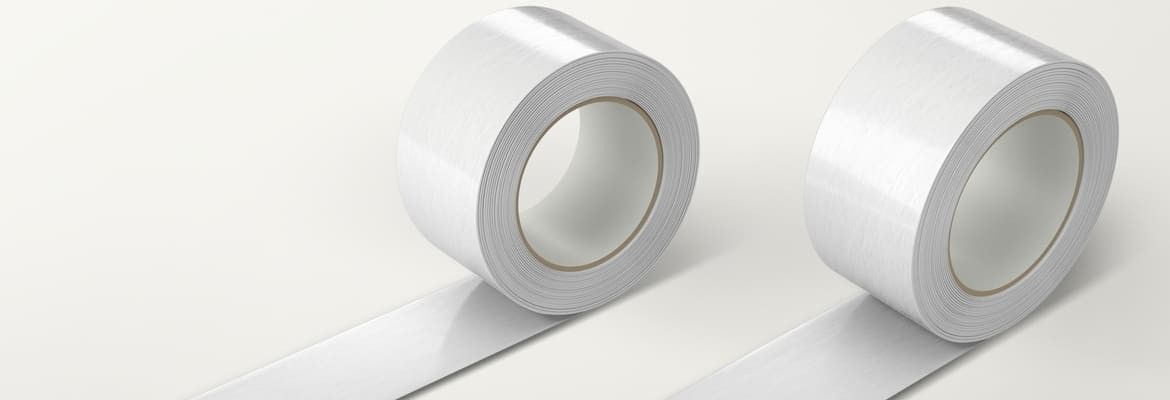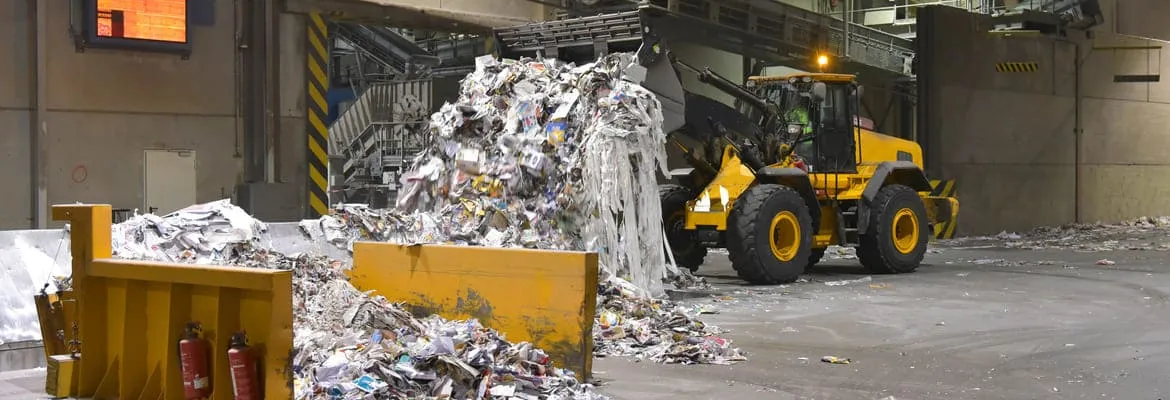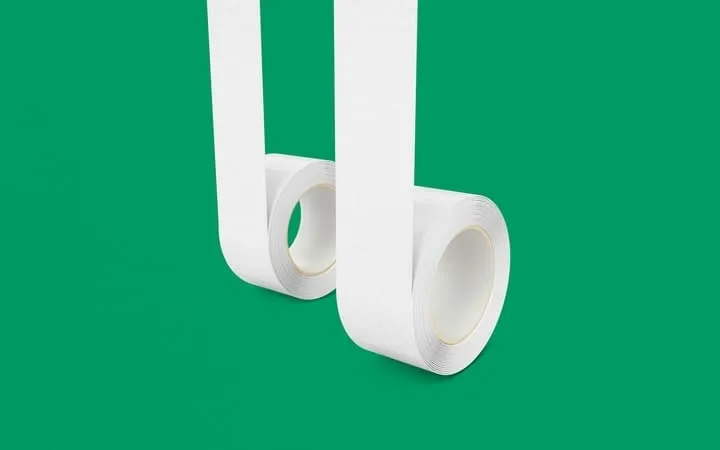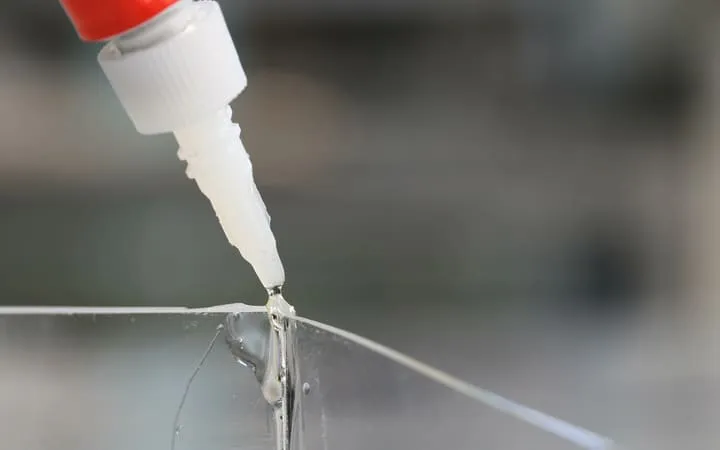
What are linerless labels?
A world without labels is hardly imaginable in industrialised nations like Germany. All the more disheartening is the thought that fifty percent of a label ends up in the landfill. Because after the labels have been applied, the backing materials and die-cutting grids have to be disposed of - in Europe alone, this results in ten thousand truckloads of paper waste per year. By using linerless labels, these quantities can be reduced.

What are linerless labels?
Definition: Linerless Labels
Ordinary self-adhesive labels are made of three layers. The upper material, i.e. the actual label, adheres to the liner with the help of an adhesive. This is coated with silicone and, in addition to its transport function, also protects the adhesive from contamination and drying out.
After the label has been applied, the liner is disposed of as a waste product. Linerless labels that do without this layer completely are called linerless labels. They are similar in structure to classic adhesive tapes: The adhesive layer lies directly on the underlying paper layer and only bonds with the substrate under pressure.
The surface of the label, on the other hand, is provided with a silicone-containing release layer so that the linerless labels can also be detached from each other without a backing material.

This is how linerless labels are produced
In most cases, linerless labels are made of thermal paper, which can be printed in colour. In rare cases, other papers or transparent foils are also used. In any case, the material must be temperature-sensitive and therefore printable using the direct thermal process. Other printing processes are not suitable for linerless labels, as these have a silicone-containing release layer to which conventional dyes cannot adhere. Linerless labels are therefore printed just before labelling and must then be applied immediately.
A linerless label consists of these components
High-quality thermal paper with a closed surface
The paper for linerless labels should have as closed a surface as possible. Open-pored paper carries the risk that the liquid silicone will penetrate the paper. As a result, printed information can be lost, the adhesive can lose its adhesion and deposits can form on the thermal head of the printing system. The subsequent cleaning processes take up far more resources than the purchase of a high-quality paper with a closed surface. For this reason, topcoated thermal papers are commonly recommended, as their optimal surface properties allow the silicone to stay in place and crosslink well.

High-viscosity silicone and hot-melt adhesive
If you want to produce linerless labels, you have to choose not only the right paper but also the right adhesive and a UV-curing, high-viscosity silicone. Low-viscosity substances can penetrate the surface of the paper, where they cannot be sufficiently crosslinked. There are also some demands on the adhesive. Substances that are too watery can affect the paper structure, which becomes corrugated during drying and unusable for labeling.
Both solvent-based and dispersion adhesives cannot be used for this reason. The majority of linerless labels are made with radiation-curing hot melt adhesives instead. Here, you should ensure that the adhesive does not cause any contamination in the printing and cutting system. It must also ensure reliable adhesion and be removable from the silicone layer.
Possible applications for linerless labels
Linerless labels are only available in rectangular form
Due to the elimination of the backing paper, linerless labels cannot be die-cut into any particular shape at this time. Although they can be cut to the desired size depending on the needs of their users, the shape always remains rectangular. The cut can be made with the help of a special direct thermal printer, which brings the continuous roll into the required format, or it can be specified by a perforation.
Linerless Labels for Temporary Marking and Shipping
Linerless labels are mainly suitable for applications in which goods are to be labeled with short-term information. This applies, for example, to shipping cartons or the posting of promotional prices in stores. For some goods, the label can also be used as a packaging seal. It should be noted, however, that linerless labels are more difficult to customize than conventional labels due to their prescribed rectangular shape and the limited options for colouring and printing. For this reason, they are perceived by many end consumers as less appealing and are not suitable for encouraging people to buy.
The advantages of linerless labels at a glance
Linerless labels are significantly more environmentally friendly
Eliminating the liner also means eliminating waste. With linerless labels, the entire roll can be used; there is no need for liner paper or die-cutting grids. As a result, you save about forty percent in material compared to conventional adhesive label rolls. CO₂ emissions in the production, transport and disposal chains can thus be significantly reduced.
Using linerless labels saves space, time and money
Because the label material of linerless labels is significantly thinner, a roll of the same diameter can fit a significantly higher number of labels.
As a result, rolls need to be replaced less often, equipment maintenance cycles are longer, and you can ensure faster operations.
In addition, linerless labels take up less space because they can be cut to any length and there is no need to store different sizes. Ultimately, these features can help you reap high savings on storage, transportation and material costs.

Do linerless labels have any disadvantages?
To process linerless labels, you need professional printers that are suitable for the material and can also cut it to size immediately. The latter is only not necessary for rolls with perforations, which are then less flexible. Only the direct thermal process is possible for printing, which means that the labels have a shorter shelf life than the adhesive paper variant: since the adhesive side is unprotected and could become contaminated, the label must be affixed shortly after printing.
Conclusion: Linerless labels are so valuable
Linerless labels are also known as release liner-free labels and are a sustainable alternative to the classic liner version. By fitting far more labels on a roll due to the absence of a liner, money, storage space and operating time can be saved. By avoiding waste and its disposal, linerless labels are also much more environmentally friendly. Linerless labels are still a niche product with limited applications, but they are ideally suited for the short-term labeling of goods or shipping items.




